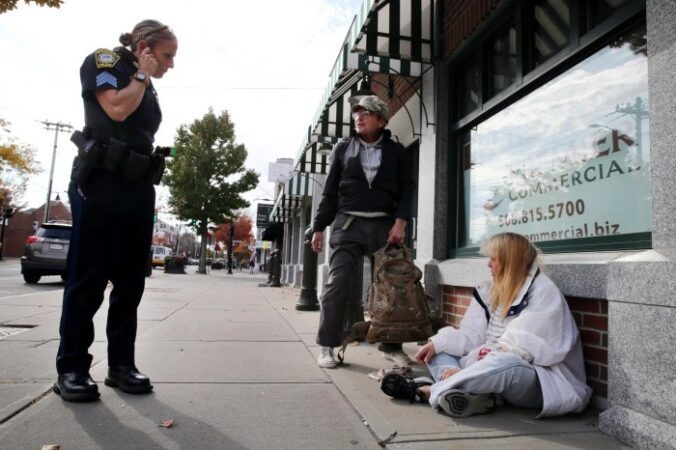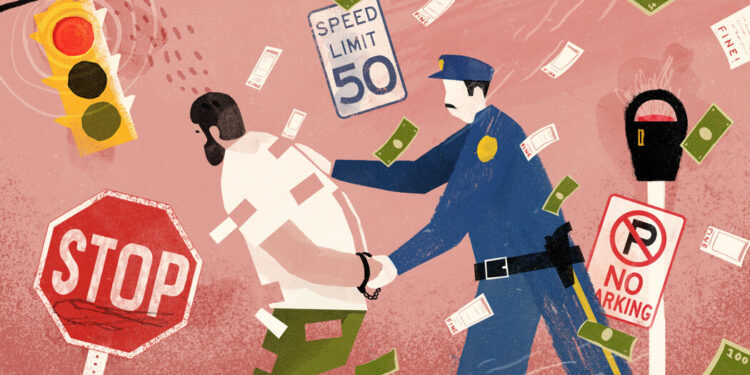
Is loitering against the law? This question sparks a complex debate, weaving together legal definitions, constitutional rights, and societal perceptions. Loitering, often perceived as suspicious or even criminal, carries a stigma that can be unfairly applied, particularly within marginalized communities. This exploration delves into the legal frameworks surrounding loitering, examining its definition, the laws that govern it, and the potential for bias in its enforcement.
From exploring the nuances of legal definitions to analyzing the impact of loitering laws on various communities, this discussion aims to shed light on the intricacies of this often-overlooked legal concept.
Defining Loitering

Loitering is a term that often evokes images of suspicious individuals lurking in shadowy corners or hanging around public places without a clear purpose. While this perception may be prevalent, the legal definition of loitering is more nuanced and varies considerably depending on the jurisdiction.
Legal Definition of Loitering
The legal definition of loitering typically involves a combination of elements, including:
* Presence in a public place: Loitering generally occurs in areas accessible to the public, such as streets, parks, or businesses.
* Lack of a legitimate purpose: The individual’s presence in the public place must lack a clear and lawful reason.
* Intent to engage in unlawful activity: This element is often the most contentious, as it requires proving the individual’s intention to commit a crime.
* Time and conduct: The length of time spent in the public place and the individual’s conduct can also be considered.
Common Elements of Loitering
The specific elements that constitute loitering vary depending on the jurisdiction. However, some common elements include:
* Presence in a prohibited area: Certain areas may be designated as off-limits to loitering, such as school zones, private property, or areas known for criminal activity.
* Suspicious behavior: Conduct that raises suspicion, such as staring intently at people, repeatedly looking over one’s shoulder, or making furtive movements, can be considered loitering.
* Refusal to leave: When asked by law enforcement or security personnel to leave a particular area, refusing to do so can be considered loitering.
Examples of Loitering
Here are some examples of activities that are typically considered loitering:
* Standing around in a public place with no apparent purpose: This could include individuals hanging around on street corners, in parking lots, or near bus stops without any clear reason for being there.
* Repeatedly walking past the same location: This can be considered suspicious behavior, especially if the individual is doing so without a legitimate reason.
* Gathering in groups in a public place without a clear purpose: Large groups of individuals congregating in public places, especially if they are acting suspiciously or making noise, can be deemed loitering.
* Soliciting for money or services: While not always illegal, soliciting for money or services in a public place can be considered loitering if it is done in a disruptive or harassing manner.
Legal Frameworks and Laws
Loitering laws are a common feature of legal systems around the world, although their specific definitions, applications, and penalties vary considerably. These laws aim to address concerns about public safety, order, and the potential for criminal activity.
Loitering Laws in the United States
In the United States, loitering laws are typically found at the state and local levels, with variations in their wording and application. Many states have “vagrancy” or “loitering” statutes that criminalize specific behaviors, such as:
- Standing or remaining in a public place for an unreasonable length of time without a lawful purpose. This can include lingering in doorways, alleys, or parks without a clear reason for being there.
- Being in a public place at an unusual or suspicious hour. This often targets individuals who are out late at night, particularly in areas known for crime.
- Soliciting or engaging in prostitution. This is often included in loitering laws as a way to target individuals who are engaging in sex work.
The penalties for violating loitering laws can range from fines to arrest, depending on the specific offense and the jurisdiction.
Loitering Laws in the United Kingdom
In the United Kingdom, loitering laws are less common than in the United States. The main legal framework for addressing loitering-related concerns is through the Public Order Act 1986, which includes provisions for:
- Causing harassment, alarm, or distress. This covers situations where an individual’s behavior in a public place causes discomfort or anxiety to others.
- Disorderly conduct. This encompasses behavior that disrupts public peace or order, such as shouting, fighting, or making excessive noise.
- Obstructing a highway. This prohibits blocking public pathways or roads, which can be relevant to loitering situations where individuals are congregating in a way that impedes traffic or pedestrian movement.
While there are no specific loitering laws in the UK, these broader provisions can be used to address concerns about individuals who are lingering in public places without a legitimate reason.
Comparison of Legal Frameworks
The following table Artikels key provisions of loitering laws in the United States and the United Kingdom:
| Provision | United States | United Kingdom |
|---|---|---|
| Specific Loitering Laws | Yes, often at state and local levels | No specific laws, but broader provisions exist |
| Common Elements | Standing or remaining in public for an unreasonable time without a lawful purpose, being in a public place at an unusual hour, soliciting or engaging in prostitution | Causing harassment, alarm, or distress, disorderly conduct, obstructing a highway |
| Penalties | Fines, arrest | Warnings, fines, arrest |
It is important to note that loitering laws can be controversial, as they can be used to target individuals based on their appearance, race, or socioeconomic status. Additionally, vague definitions of “unreasonable” or “suspicious” can lead to arbitrary enforcement.
Constitutional Considerations

Loitering laws, while seemingly innocuous, can potentially clash with fundamental constitutional rights, particularly the right to freedom of movement and assembly. This tension arises from the inherent ambiguity of loitering laws, which often lack clear definitions and rely on subjective interpretations by law enforcement.
The Right to Freedom of Movement and Assembly
The First Amendment of the U.S. Constitution guarantees the right to assemble peaceably and the right to freedom of movement. These rights are not absolute and can be restricted in certain circumstances, such as when there is a clear and present danger or when the exercise of these rights interferes with the rights of others. However, loitering laws, if overly broad or vaguely defined, can be used to suppress legitimate activities protected by the First Amendment.
Judicial Interpretation of Loitering Laws
Courts have recognized the potential for loitering laws to infringe upon constitutional rights and have developed a framework for interpreting these laws in a way that balances public safety with individual liberties. Key considerations include:
- Vagueness: Loitering laws must be clearly defined to avoid being overly broad and subject to arbitrary enforcement. Courts have struck down loitering laws that are too vague, as they can chill protected activity and lead to discriminatory enforcement.
- Intent: Courts often focus on the intent of the individual being accused of loitering. If the individual is engaging in a legitimate activity, such as waiting for a friend or observing a public event, a loitering charge may be deemed unconstitutional.
- Time, Place, and Manner: Courts may consider the time, place, and manner of the individual’s conduct when evaluating the constitutionality of a loitering charge. For instance, loitering in a public park at night might be deemed more suspicious than loitering in a busy street during the day.
Examples of Legal Challenges to Loitering Laws
There have been numerous legal challenges to loitering laws based on constitutional grounds. Here are some notable examples:
- Papachristou v. City of Jacksonville (1972): The Supreme Court struck down a Jacksonville, Florida, loitering ordinance as unconstitutionally vague. The ordinance prohibited “any person … who habitually loafs, loiters, or wanders upon the streets or in or about any public place or establishment, without apparent reason or business.” The Court found that the ordinance was too broad and could be applied to innocent activity, violating the due process clause of the Fourteenth Amendment.
- Kolender v. Lawson (1983): The Supreme Court struck down a California law that required individuals to “provide a credible and reliable identification” when stopped by law enforcement. The Court held that the law was vague and allowed for arbitrary enforcement, potentially chilling the exercise of the right to freedom of movement.
Law Enforcement Practices

Law enforcement officers play a crucial role in addressing loitering concerns. Their actions, however, must be guided by legal frameworks, constitutional principles, and best practices to ensure fairness and prevent abuse.
Interactions with Suspected Loiterers
Law enforcement officers often encounter individuals suspected of loitering. These interactions can range from brief inquiries to formal arrests, depending on the circumstances and the specific laws in place. Here are some common practices:
- Observation and Inquiry: Officers may observe individuals in public spaces and, if they suspect loitering, approach them to ask questions about their presence and activities. These inquiries are typically brief and focus on establishing the individual’s purpose and whether they are engaged in any illegal activity.
- Request for Identification: In some cases, officers may request identification from individuals suspected of loitering, especially if their behavior raises further suspicion. However, the legal basis for requiring identification can vary by jurisdiction.
- Warnings and Citations: If an officer determines that an individual is violating a loitering ordinance, they may issue a warning or a citation. Warnings are generally informal notices, while citations are formal documents that can result in fines or court appearances.
- Arrests: In situations where loitering is considered a criminal offense, officers may make arrests. This typically occurs when individuals refuse to comply with officer instructions or when there is probable cause to believe they are engaged in illegal activity.
Potential for Bias and Discrimination
Loitering laws, by their nature, can be subjective and open to interpretation. This subjectivity can lead to potential bias and discrimination in their enforcement.
- Racial Profiling: Studies have shown that loitering laws are often disproportionately enforced against individuals of color, particularly in minority communities. This is often attributed to implicit biases and stereotypes that can influence police officers’ perceptions and actions.
- Social Class and Appearance: Individuals from lower socioeconomic backgrounds or those with unconventional appearances may be more likely to be targeted for loitering offenses. This can be due to societal prejudices and assumptions about certain groups.
- Discretionary Enforcement: Loitering laws often grant officers significant discretion in deciding whether to intervene. This can lead to inconsistencies in enforcement, with some individuals being targeted more frequently than others based on factors unrelated to actual law violations.
Best Practices for Law Enforcement
To mitigate the potential for bias and ensure fair and effective enforcement of loitering laws, law enforcement agencies should adopt best practices:
- Clear and Objective Criteria: Loitering ordinances should be clearly defined, with specific and objective criteria for determining a violation. This helps to reduce subjectivity and ambiguity in enforcement.
- Training and Awareness: Officers should receive comprehensive training on the proper application of loitering laws, including the potential for bias and discrimination. This training should emphasize de-escalation techniques, respectful communication, and culturally sensitive interactions.
- Data Collection and Analysis: Agencies should collect and analyze data on loitering enforcement to identify any patterns or disparities that may indicate bias. This data can be used to improve policies and practices.
- Community Engagement: Law enforcement agencies should engage with community members, particularly those in minority communities, to understand their concerns and perspectives on loitering laws. This engagement can help build trust and ensure that enforcement is perceived as fair and equitable.
- Alternative Responses: In situations where loitering is not associated with criminal activity, officers should consider alternative responses, such as providing resources or connecting individuals with social services. This can help address underlying issues that may contribute to loitering.
Social and Cultural Perspectives: Is Loitering Against The Law
Perceptions of loitering are often influenced by a complex interplay of social and cultural factors, shaping how communities and law enforcement view individuals who linger in public spaces. Understanding these factors is crucial for evaluating the effectiveness of loitering laws and exploring alternative approaches to public safety.
Impact of Loitering Laws on Marginalized Communities
Loitering laws can disproportionately impact marginalized communities, particularly those already facing social and economic disadvantages. These laws can be used to target individuals based on their race, ethnicity, gender, sexual orientation, or socioeconomic status, leading to unfair and discriminatory enforcement.
- Racial Profiling: Loitering laws can be used as a pretext for racial profiling, where law enforcement officers target individuals based on their race or ethnicity rather than on any actual criminal activity. Studies have shown that Black and Hispanic individuals are more likely to be stopped and questioned for loitering than their white counterparts, even when engaging in similar behaviors.
- Homelessness and Poverty: Individuals experiencing homelessness often face scrutiny under loitering laws, as they may be forced to spend time in public spaces due to a lack of affordable housing. This can lead to arrests and fines, further marginalizing those already struggling.
- Youth and Teenagers: Young people, particularly teenagers, are often targeted by loitering laws, leading to unnecessary arrests and criminal records. These laws can create a perception of youth as inherently suspicious, even when engaging in normal social activities.
Alternative Approaches to Public Safety, Is loitering against the law
Addressing public safety concerns related to loitering requires a nuanced approach that goes beyond simply enforcing laws. Alternative strategies can help foster community engagement, promote social inclusion, and address underlying issues contributing to public safety concerns.
- Community Policing: Building strong relationships between law enforcement and communities can help address public safety concerns through collaborative problem-solving. This approach emphasizes communication, trust, and shared responsibility, fostering a sense of ownership and involvement in community safety.
- Social Services and Resources: Providing access to social services and resources can help address underlying factors contributing to public safety concerns. This includes offering housing assistance, job training, mental health services, and substance abuse treatment.
- Public Space Design and Management: Designing public spaces that are welcoming and inclusive can encourage positive social interaction and reduce the perception of loitering. This includes creating spaces that are well-lit, accessible, and offer opportunities for recreation and social engagement.
Ultimate Conclusion
Ultimately, understanding the complexities of loitering laws requires a nuanced perspective that considers both legal frameworks and social realities. While the purpose of such laws is often to maintain public safety, their implementation must be approached with caution to avoid unfairly targeting individuals based on assumptions or stereotypes. Moving forward, fostering open dialogue and promoting fair and equitable enforcement practices are crucial steps towards ensuring that loitering laws are applied justly and effectively.
Questions Often Asked
What are some examples of activities that might be considered loitering?
Standing or remaining in a public place without a clear purpose, lingering in a particular area, or engaging in behavior that appears suspicious or disruptive can all be considered loitering. However, the specific activities that constitute loitering vary depending on local laws and circumstances.
Can I be arrested for loitering if I am simply waiting for someone?
It depends. Law enforcement officers generally have the discretion to determine if someone is loitering based on their behavior and the context of the situation. If you are waiting for someone and can provide a reasonable explanation for your presence, you are less likely to be arrested. However, it is always best to be respectful of law enforcement and cooperate with their requests.
What are the penalties for violating loitering laws?
Penalties for loitering violations can range from warnings and fines to arrests and even jail time. The specific penalties vary depending on the jurisdiction and the severity of the offense.





